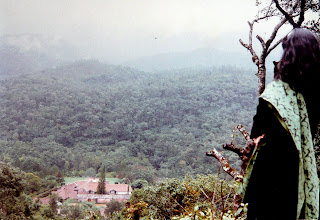Among the ruins of a forgotten empire
Work takes me to different parts of south India outside Kerala. Last week, I went to Goa, travelled to Hubli and then to Hospet. Then it was to Kurnool via Bellary and to Guntakkal from where a train brings me back to Tripunithura.
Each of these places is different from the other. Summer is quite felt all over but the liveliness of the country is all pervading.
 Virupaksha
Virupaksha One Saturday night I reached Hospet from Hubli. The next day being holiday, I decided to spend the time in Hampi, among the ruins of the forgotten empire, Vijayanagara. Mohan, an employee of our company is a local lad and he was to be my guide. He arranged an auto rickshaw for a day so that we could leisurely move around in this UNESCO world heritage site at Hampi spread over many square kilometers. This village was the site of the last great Hindu empire of Vijayanagara which was fabulously prosperous as described in the writings of travelers of the 14th to 16th centuries.
Arab traveler Abdul Razaak (1442), Portuguese travelers Domingo Paes (1522), Fernao Nuniz (1535) and Italian traveler Nicolò Conti (1420) all have left glorious accounts of the rich princes and of the prosperity of this amazing kingdom. In the market places of Vijayanagara, it has been chronicled, precious metals and stones used to be traded with the casualness of other cheap merchandise reflecting the prosperity of this great empire. Founded in 1336, the empire reached its zenith during the reign of Krishnadevaraya (r.1509-29 who won many battles and extended the empire considerably. Its tragic end came in 1565 in the battle of Talikotta in which the combined armies of the Deccan sultans defeated and killed King Ramaraya. The city was plundered for six months and left abandoned bringing down the curtains on one of the most prosperous kingdoms the world had seen.
Musician on a pillar
Describing one of the battle victories of Krishnadevaraya, the Spanish writer, Faria y Souza writes, thus:
"While the governor was in the Red Sea, the King Crisnao Rao of Bisnaga covered the plains and hills and stopped the flow of the river with an army of thirty-five thousand horse, seven hundred and thirty-three thousand foot, and five hundred and eighty-six elephants carrying castles with four men in each, and twelve thousand watermen ... and baggage in such quantities that the courtesans alone numbered more than twenty thousand.”
What great army he might have had, I wonder!
I recommend the book, "A forgotten empire: Vijayanagar; a contribution to the history of India" (Includes a translation of "Chronica dos reis de Bisnaga," from Domingos Paes and Fernao Nuniz from 1520 and 1535 respectively) by Robert Sewell to anyone wanting to read the stunning rise and fall of Vijayanagara. It can be freely downloaded from the web.
While walking among the ruins of the great city, I told Mohan that I was not actually seeing the excavated sites. My mind had taken a trip in a time machine which took me back by 500 years. I was seeing Krishnadevaraya with his consort on a fine evening coming in royal procession to the Virupaksha temple premises. Caparisoned elephants, horses, chariots and the infantry were in the places allocated. The beautiful citizens of Vijayanagara in festive moods were walking around the market place appreciating the beauty of various merchandise displayed for sale. The musicians, dancers, courtesans and other artists were aplenty. Scholars, ambassadors from other countries and governors of provinces and other vassals were arriving in great numbers. The whole city smelled of silk, sandalwood and other perfumes......
 Ornate pillars of Vittala temple
Ornate pillars of Vittala temple Lotus Mahal
Lotus Mahal River Tungabhadra behind Virupaksha Temple
River Tungabhadra behind Virupaksha Temple Ugra Narasimha hewn out of a single boulder of granite 1528
Ugra Narasimha hewn out of a single boulder of granite 1528 Magnificient stone chariot in the Vittala temple complex
Magnificient stone chariot in the Vittala temple complex The elephant stable
The elephant stableAs the shadows grew longer, I returned to the cool premises of the hotel room with my mind wandering around the events of an era gone by.
Unfortunately, Sindhu my wife was not there with me to see all these in spite of the day being the 28th anniversary of our wedding.
Tripunithura, South India.
24th May 2011








Comments
Thanks for the appreciation.Yes, you must visit these places sometime which shall make you proud of our heritage.All best wishes!